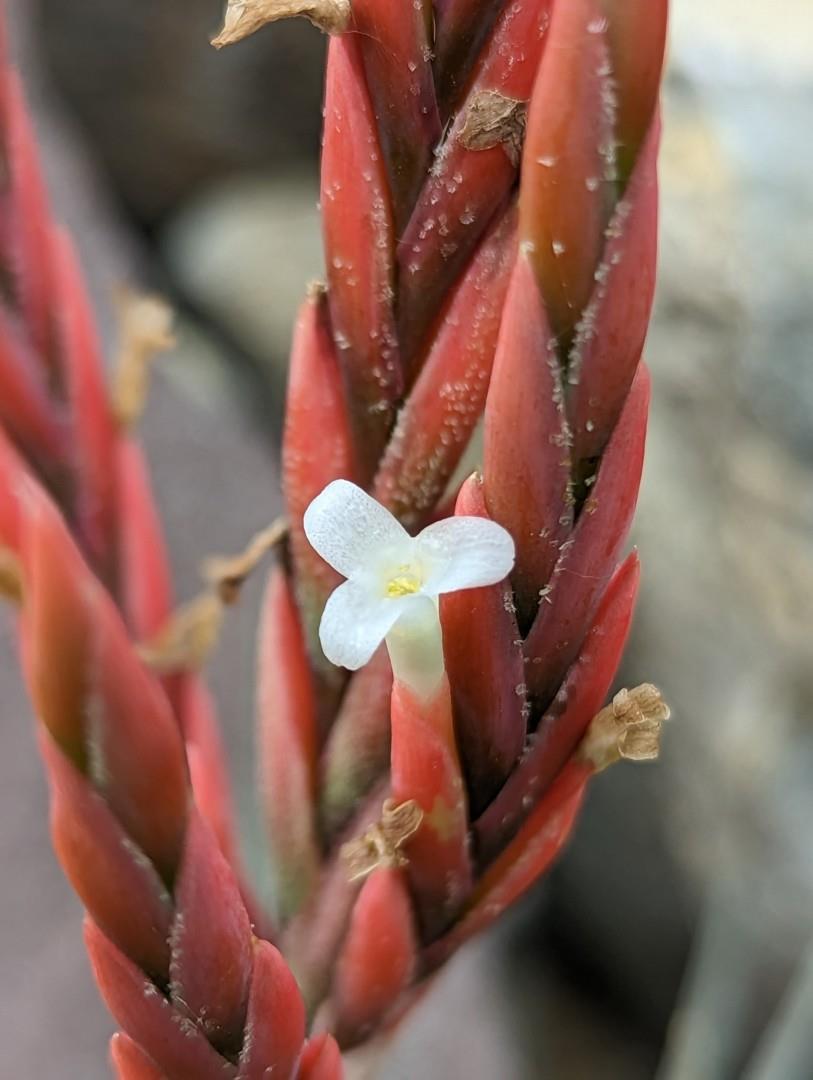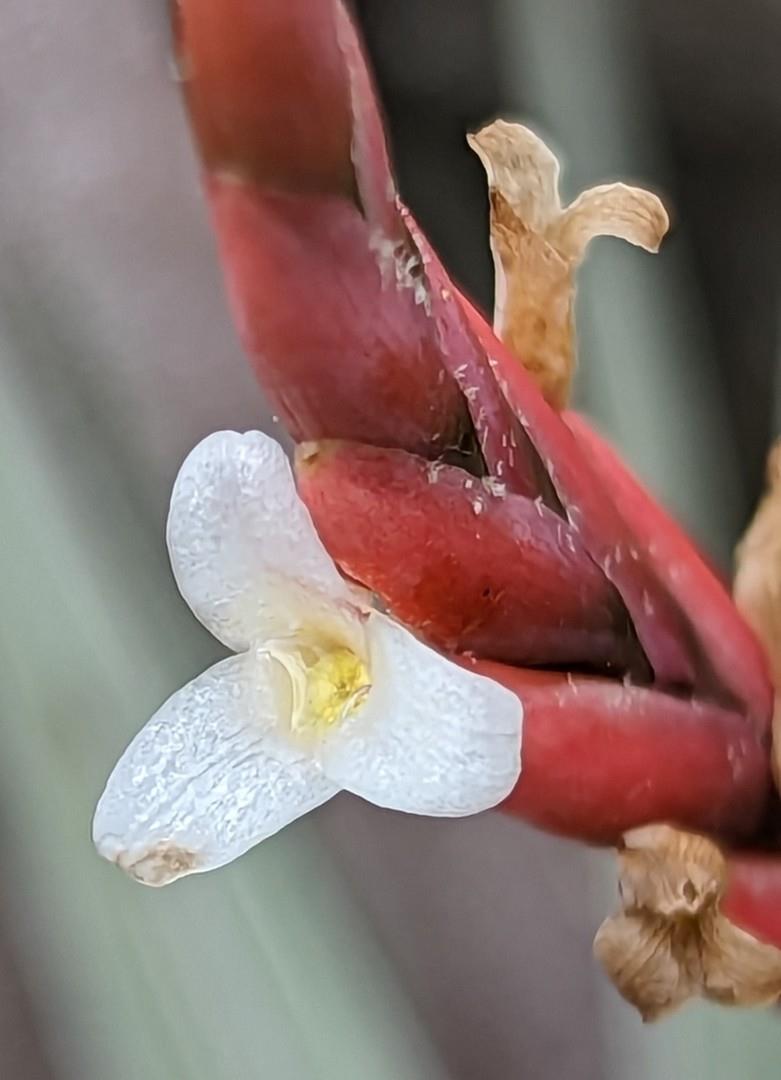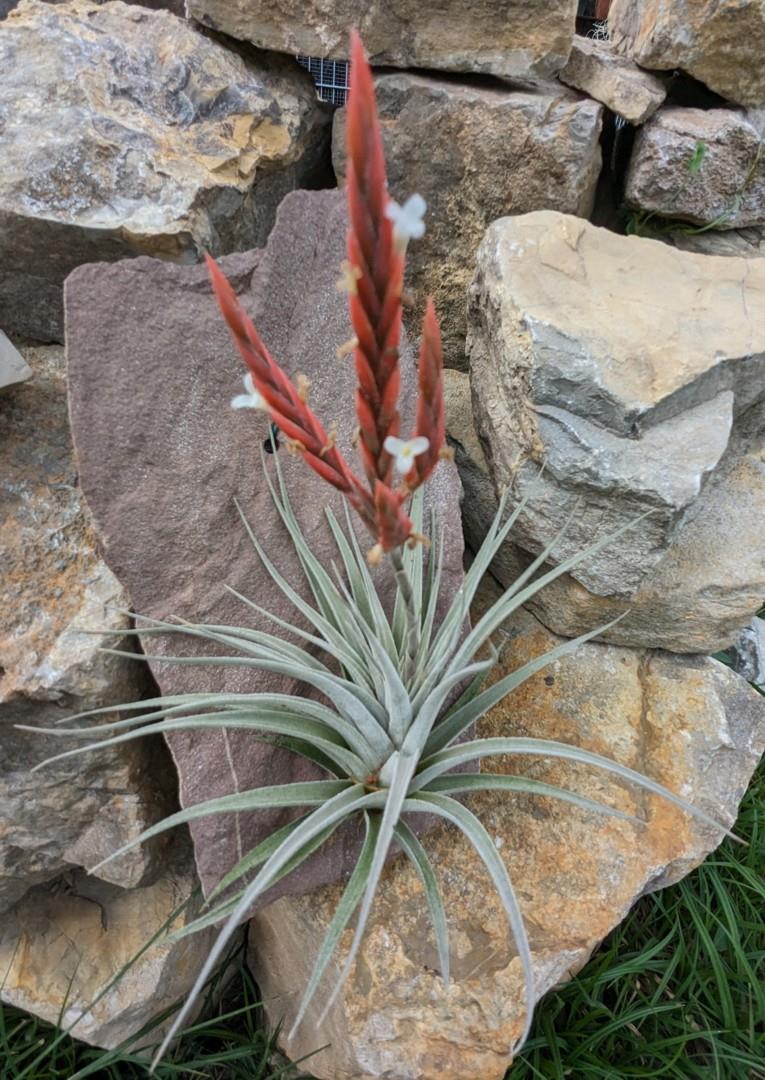






A Tillandsia didisticha (E. Morren) Baker foliis pruinose lepidotis, bracteis florigeris glabris majoribusque et sepalibus bracteis brevioribus (vel maxime aequantibus) differt.
A T. lorentziana Griseb. foliis brevioribus (10-12cm versus (13-)19-26(-40) et angustioribus (7-9mm versus (13-)16-32mm), magis pruinosis, externis non reflexis et bracteis florigeris sepalisque brevioribus recedit.
TYPUS: Brasil: Goias, Corumba de Goias perto de Cocheiro, 1 Oct 1966, leg. G. M. Barroso s/n (= HB 39691).
Holotypus: plant with simple inflorescence (HB). Isotypus: plant with branched inflorescence (HB), both mounted on one sheet.
PLANT stemless, flowering 16-17cm high.
ROOTS numerous, very stiff, well developed as holdfasts.
LEAVES numerous, forming a dense, slightly secund rosette, erect, the outer not reflexed.
LEAF SHEATHS inconspicuous, merging into the leaf blades.
LEAF BLADES very narrowly triangular, 7-9mm wide at base and 10-12cm long, densely pruinose with the trichomes asymmetrically elongated towards the basis of the leaf, leaf margins convolute and forming an adaxial channel.
INFLORESCENCE SCAPE equalling the leaves and densely covered by abaxially lepidote and acuminate bracts, the upper bracts with hyaline margins.
INFLORESCENCE simple or digitate of two spikes.
RHACHIS nearly straight, angled, glabrous.
SPIKES with 7-9 distichously arranged and imbricate flowers, 4-4.5cm long and 1-1.2cm wide.
FLOWERS about 2mm pedicellate.
FLORAL BRACTS red (Barroso!) nerved, glabrous on both sides, faintly carinate, acute, 16.5-18.5mm long in the middle of the spike, usually surpassing the sepals for 1-2mm, somewhat spreading in dry state.
SEPALS lanceolate, 14-15mm long, acute, glabrous, nerved, with broad hyaline margins, the abaxial ecarinate and connate for 1mm, the adaxial carinate and connate for 2mm.
PETALS white (Barroso!), ca. 20mm long.
Detail in Bromelia 1999
Herbarium collections often are the source of interesting specimens and even of hitherto undescribed taxa. However, one must be well familiar with the differences between live plants and desiccated vouchers to be conclusive.
During a visit to the Herbarium Bradeanum (HB) in Rio de Janeiro in August 1997 two specimens of Tillandsia especially attracted the attention of the author which subsequently have been studied more thoroughly in the lab and which have been compared with larger amounts of herbarium material of related taxa. The HB specimen #39691 had been identified by L. B. Smith in November 1967 as T. lorentziana Griseb., but it was immediately clear that this was a misidentification. The plant has more in common with T. didisticha (E. Morren) Baker but is distinct from the latter too. It is consequently described as a new species.
Tillandsia barrosoae is an epilithic species of the Cerrado formation complex and is probably endemic to the Serra dos Pireneos east of Brasilia. It is geographically far remote from the area of T. didisticha which is an element of the Chaco vegetation extending into the lower portions of the eastern Andes. It reaches Brazil only in westernmost Mato Grosso state. However, in the same general area which is inhabited by T. barrosoae occurs T. goyazensis Mez which is considered a synonym of T. didisticha despite the glabrous to subglabrous floral bracts.
Tillandsia goyazensis has leaves two times the length and width of T. barrosoae and a subdigitate inflorescence of (3-)6-8 spikes. The sepals of T. goyazensis are equally connate for 3mm and are of the same length as the floral bracts if not longer, a character syndrome shared with T. didisticha. Esteves no. 7 (HB 69470: Goias, norte) matches very well the type of T. goyazensis in Berlin (B) as well as the duplicate in Kew (K) with the exception of slightly shorter floral bracts (14-15 mm), it is, however, distinct from Andean populations.
Tillandsia lorentziana has a distribution pattern similar to T. didisticha but is also known from south Brazil and the states of Bahia and Ceara. The records for Goias: Serra dos Pireneos seem to be a confusion with T. barrosoae and need re-examination.
The restricted distribution of T. barrosoae fits well into a pattern of locally endemic species or populations occurring in the temporarily dry zone (Castro et a1.,1999) at the southeastern margin of the Amazon basin and north of the adjacent Chaco. These populations obviously inhabited a wider area and even migrated over long distances during periods of drier climate and were isolated from each other during subsequent warmer periods. Today we find these young derivatives as homogeneous populations with local distribution but sometimes difficult to separate morphologically from each other. Examples are T. ramellae W. Till & S. Till in northwestern Paraguay, the populations of T. arequitae (Andre) Andre ex Mez in central Paraguay and southern Uruguay, the populations of T. vernicosa Baker in central Paraguay, T. esseriana in the Sierra de Amambay along the Brazilian border with Paraguay, T. barrosoae in Goias state, T. graomogulensis A. Silveira (syn.: T. kurt-horstii Rauh) in northeastern Minas Gerais, and a spectacular, silvery-leafed population of T. lorentziana from Bahia state (Burle-Marx s.n., WU).
Mez (1901) described four species of Bromelia which are obviously locally distributed and which are still accepted in the latest treatment (Smith & Downs, 1979). As a total, five species of Bromelia seem to be endemic to Goias state, among which B. macedoi L. B. Sm. is known only from Serra dos Pireneos. This genus exhibits another example of considerable endemism in the interior of Brazil, especially in the mountain ranges of northern Goias state. Castro et al. (1999) consider the north of Goias (now called Tocantins) to be, in common with sites in Mato Grosso, one of the species richest areas of the cerrado flora. It would be desirable to test this hypothesis for Bromeliaceae for which the available data promise a quite high amount of cerrado endemism.
This new species is named in honor of the eminent Brazilian botanist, Dr. Graziela Maciel Barroso, who originally collected T. barrosoae.
Butcher’s notes. As at 2007 T. goyazensis is still treated by Luther as a synonym of T. didisticha whereas the synonymity of T. kurt-horstii with T. graomogulensis (resurrected from T. streptocarpa) was accepted. Query the logic!